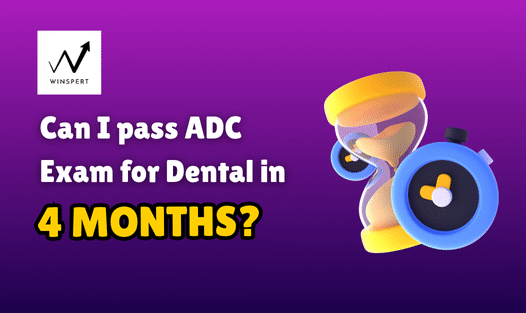A Big Yes, The Australian Dental Council (ADC) licensure pathway has three gates: Initial Assessment, Written Examination (Part 1) and Practical OSCE (Part 2). Part 1 alone is a two-day, computer-based test (4 papers × 70 scenario MCQs, 2 hours each) that measures clinical reasoning against a strict blueprint. The ADC itself recommends 3–4 months of “dedicated preparation time” for the written exam—longer only if you can’t study full-time.
Why are many overseas dentists still unable to pass it? They underestimate the breadth (12 core disciplines + 2 sub-disciplines) and fail to practise under timed conditions.
Why Four Months of Preparation for ADC Exam is Enough?
A 16-week window equals roughly 450 focused study hours if you average 28 hours per week. That’s plenty to:
- Cover every blueprint domain once.
- Drill 3,000+ high-yield MCQs twice.
- Sit eight full-length mocks.
Winspert’s own data show first-time candidates who commit ≥25 hours/week and follow a structured ADC prep schedule have pass rates above the global average. The catch? You must treat those 16 weeks like a sprint triathlon—tight plan, relentless execution, zero excuses.
The 4-Month Plan to crack ADC Australia Exam
Weeks 1-2 — Map & Gear-Up
Skim the ADC handbook, print the blueprint, note weightage.
- Collect resources: Therapeutic Guidelines, Cawson’s Oral Pathology & Oral Medicine,
- Levine’s Endodontics, ADA infection-control standards.
Choose one structured ADC course (live or on-demand). Avoid juggling three—you’ll lose coherence.
Weeks 3-6 — Foundation Blocks
- Tackle two major disciplines per week (e.g., Restorative + Dental Emergencies).
- Summarise each chapter in 200-word bullet sheets.
- End every night with 40 timed MCQs from the same topics. Target ≥70 % accuracy.
Weeks 7-10 — Integration & Speed
- Start mixed-discipline blocks. Combine Periodontics Qs with Pharmacology stems; mirror exam chaos.
- Sit your first half-length mock (140 Qs, 4 hours). Analyse mistakes for patterns—lack of recall, misreading, poor elimination.
Weeks 11-13 — Full-Dress Rehearsal
- Attempt three full-length mocks under Pearson-VUE conditions: earplugs, 30-minute lunch gap, zero phone.
- Review in 48 hours, not two weeks. Speedy feedback locks in retention.
Weeks 14-15 — Patch the Leaks
- Rank weak domains (e.g., Oral Pathology 52 %, Radiology 58 %). Do high-intensity drills only in those.
- Condense all notes into a 50-page “Rapid-Revise” PDF or flash-card deck.
Week 16 — Taper & Condition
- Last mock five days out; no heavy study after.
- Sleep regular hours, practise 4-7-8 breathing to curb cortisol.
Stick to this timeline and you’ll touch every exam objective at least twice—exactly what a competitive Australian dental exam graduate does when cramming for finals.
Study Tactics for ADC that Punch Above Their Weight
Active recall > passive reading
Close the book, recite the five steps of managing avulsed teeth. If you can’t teach it aloud, you don’t own it.
Spaced repetition beats marathon weekends
Use Anki or Quizlet to resurface tricky endo percentages every 48 hours. Cumulative recall builds neural shortcuts.
Scenario-first drilling
Start with a clinical vignette (“9-year-old, Ellis Class II fracture…”) then ask “What would I do chair-side?” Map answer to guidelines. Exam stems mirror real clinics.
Timed MCQ bursts
Set 90 seconds per question—faster than the real exam (105 seconds). Over-training makes the actual test feel roomy.
Why an Intensive ADC Course Can save Weeks Off
- Curated resources: A good ADC course cuts the 50-book jungle to the 10 that matter.
- Mentor feedback: Senior Aussie-registered dentists flag faulty reasoning you won’t spot alone.
- Accountability: Fixed live-session calendars stop Netflix creep.
Crash-track programs (8–12 weeks) run by providers like Winspert bundle graded mocks, blueprint-aligned lectures, and peer-study pods—ideal if you’re juggling clinic duties.
Common Pitfalls—and Fast Repairs
| Pitfall | Reality Check | Fix |
| “I’ll just read Mosby’s twice.” | Breadth > depth; exam covers 14 domains. | Use Mosby’s for overview, then dive into discipline-specific texts. |
| Skipping pharmacology math | 10 % of blueprint—too big to ignore. | Solve five dosage/calculation Qs daily after lunch. |
| Ignoring clinical images | Radiographs get 5 % weightage. | Review 20 bitewing + OPGs every Sunday. |
| Studying solo till the end | No benchmark = blind spots. | Schedule at least two group mocks. |
Can You Really Balance Work, Family and ADC Prep?
Yes—but audit your calendar like a CFO:
- Trim elective clinic sessions to four days/week.
- Batch errands (groceries, laundry) to Sunday afternoon.
- Negotiate “focus blocks” with family—7-9 pm weekday study, non-negotiable.
If that still leaves <20 study hours/week, extend to five months. Attempting a sub-optimal sprint just wastes the AUD 2,122 fee.
What About the Practical OSCE?
Different beast, different muscle. Nail Part 1 first—its validity lasts three years, plenty to enroll in a simulation-heavy OSCE ADC prep course later.
Four months is not a loophole; it’s a calculated, high-performance window. Follow a blueprint-based timetable, lean on a focused ADC course, and fire off relentless mock tests. Thousands of overseas dentists have crossed the line on this schedule; you can too.
Ready to start? Download Winspert’s free 16-week study tracker and book your diagnostic mock today. Pass or pass—those are the only two outcomes you should consider.

